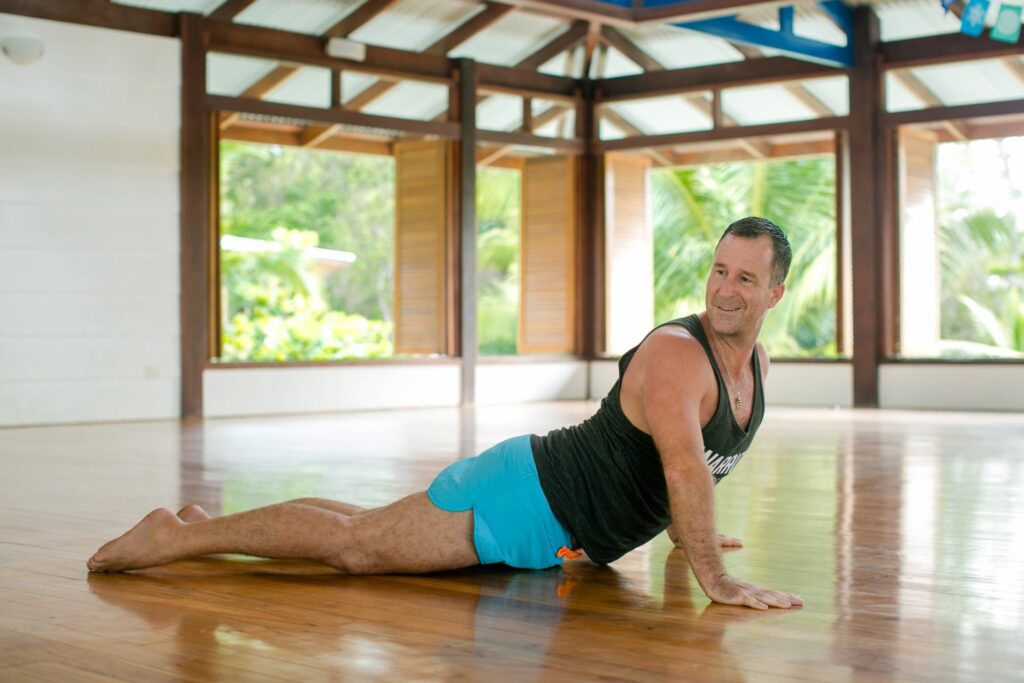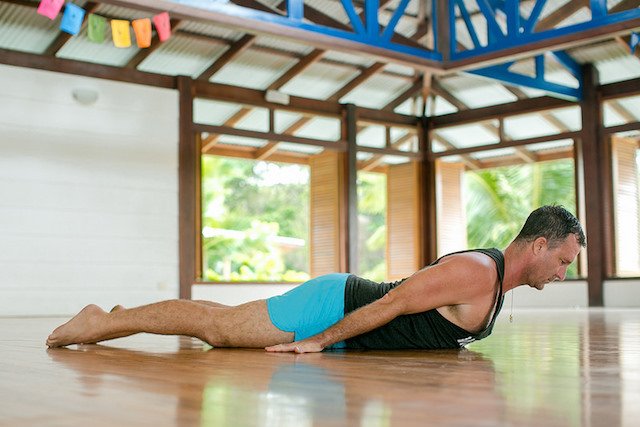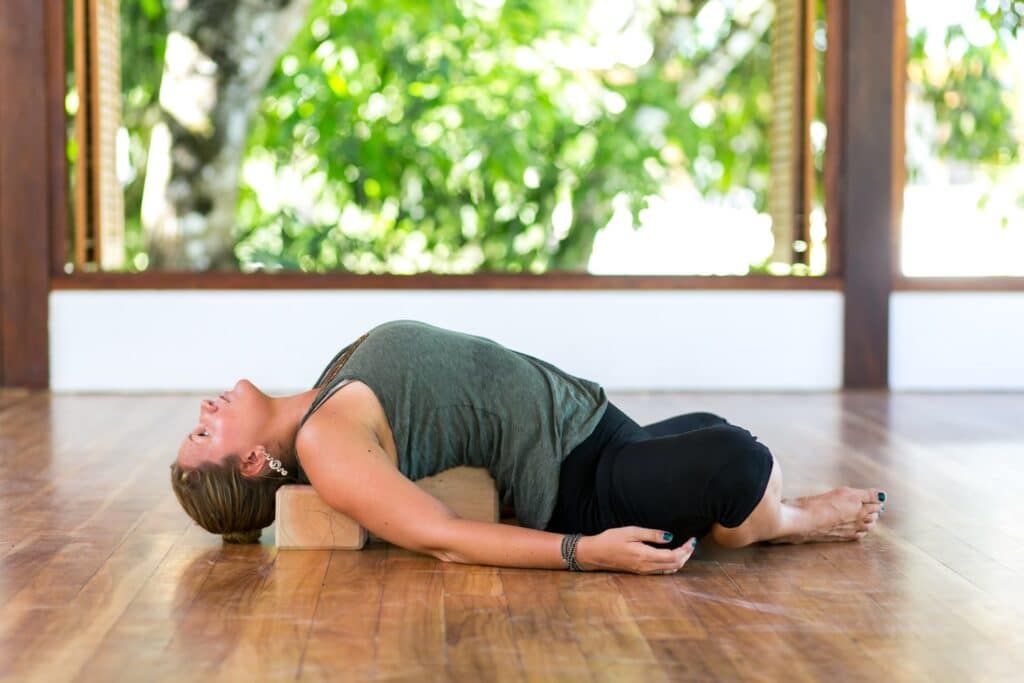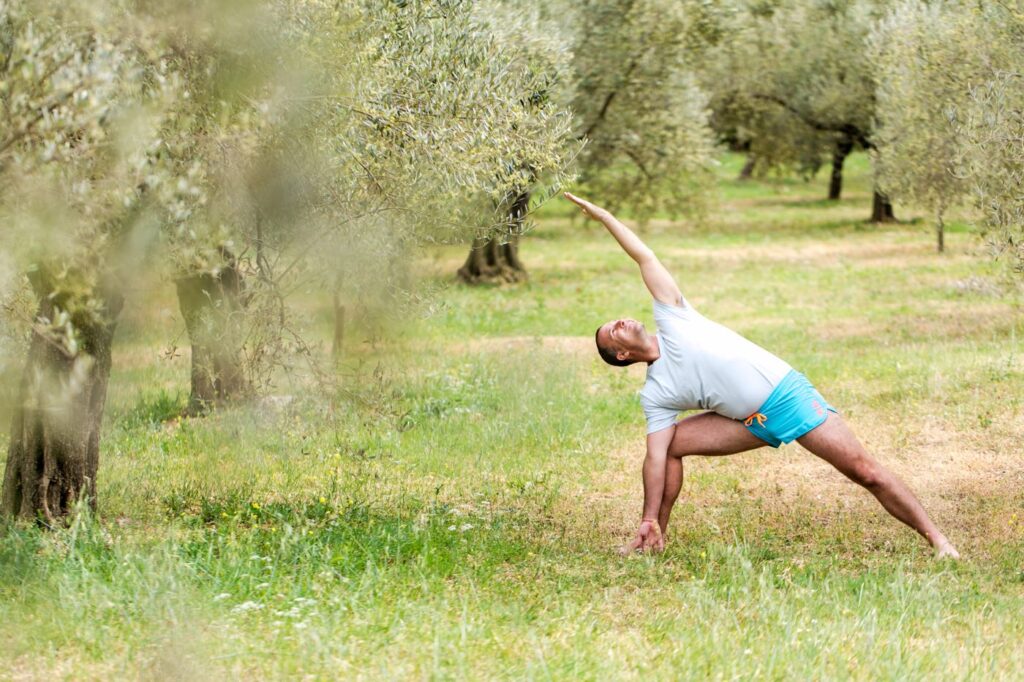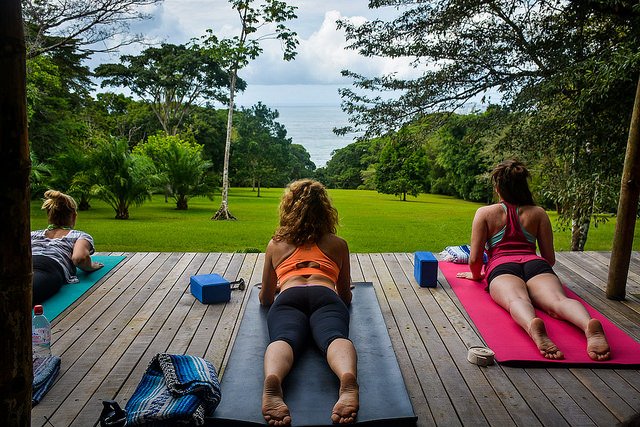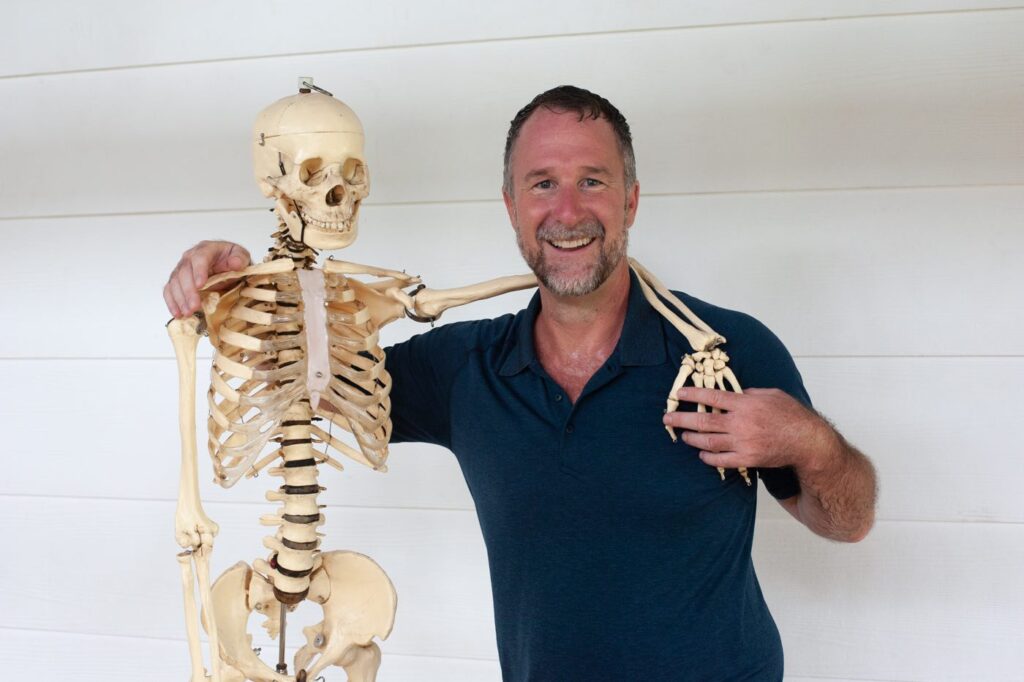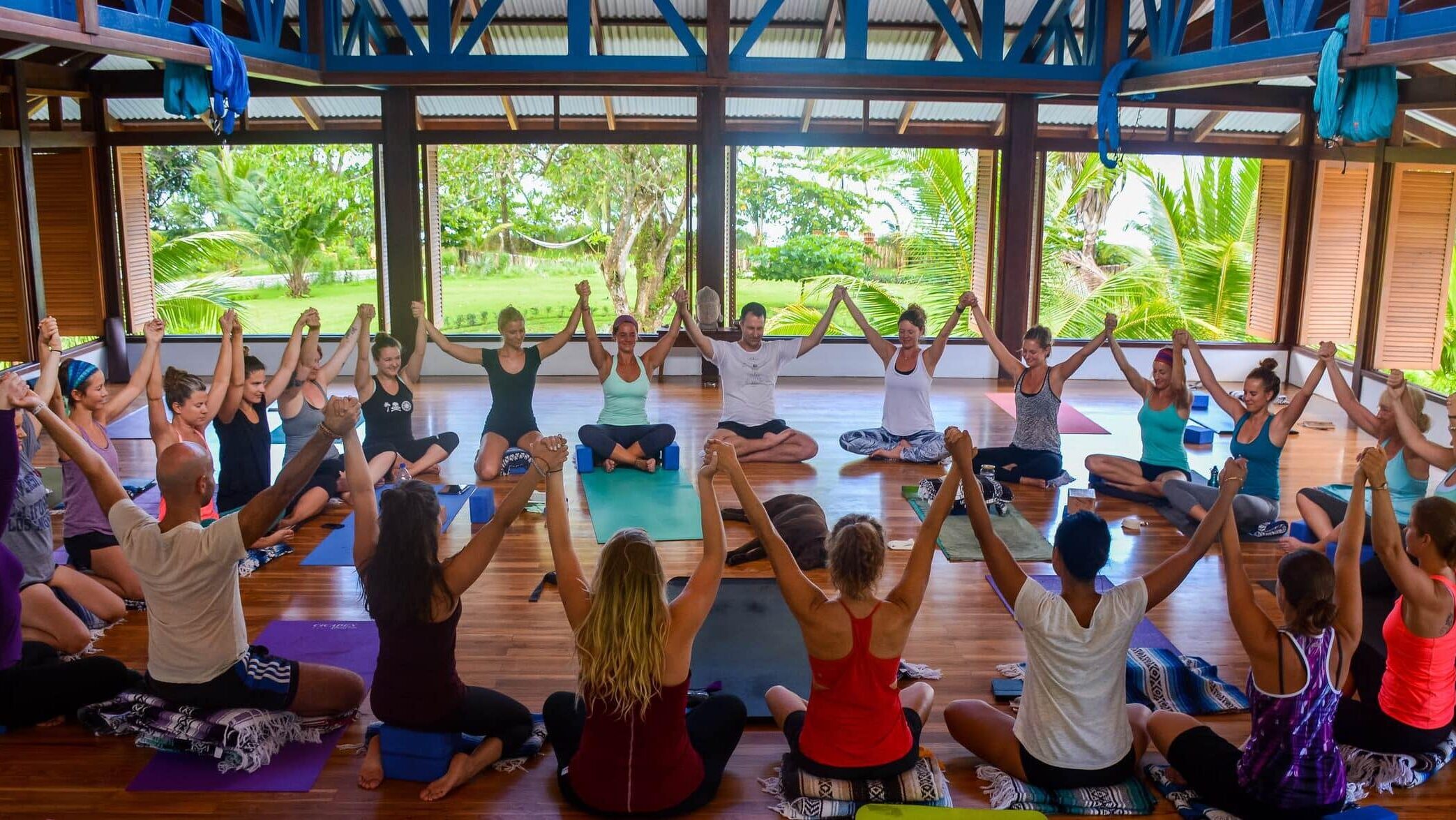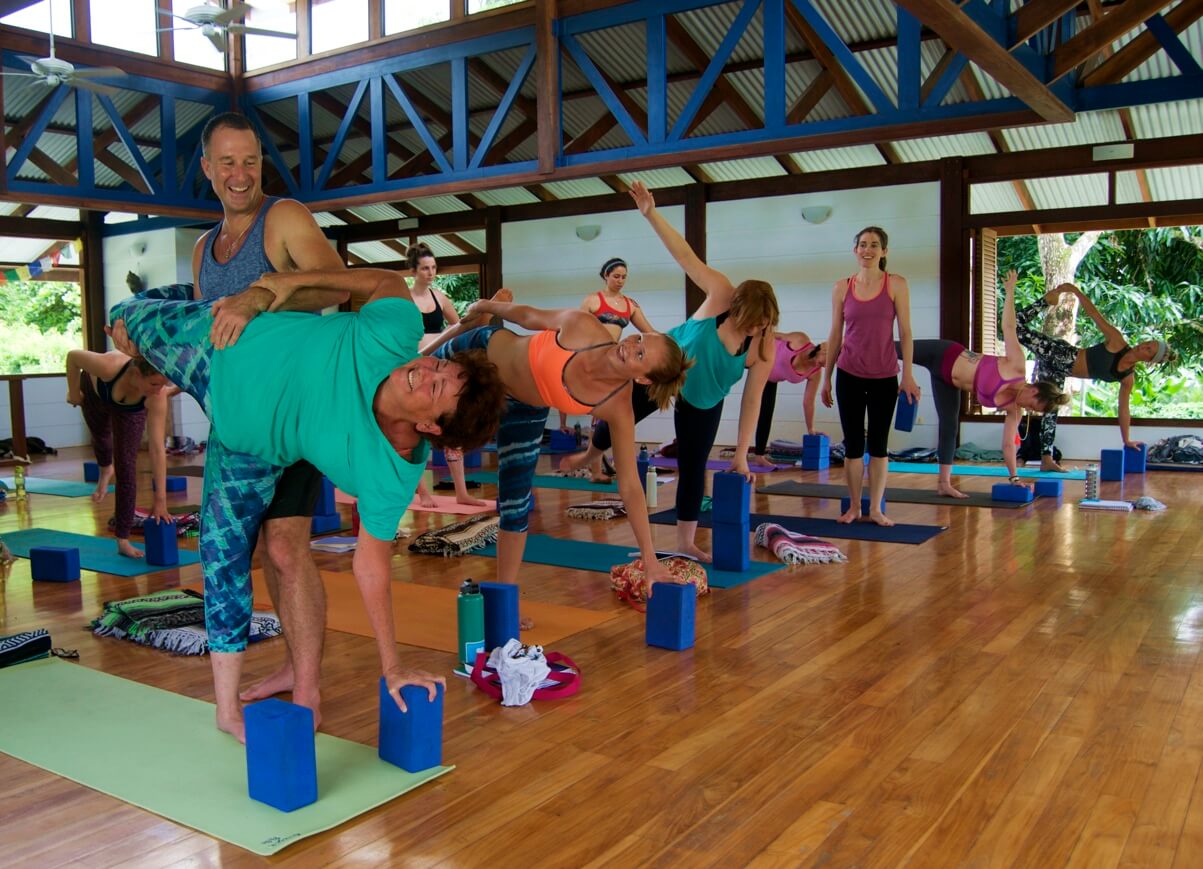Yoga poses for upper back pain can provide much-needed relief when you need it most. There’s only one problem:
Most yoga teachers are giving you instructions that will only make your back pain worse.
It’s true. You might even have experienced it firsthand…
After a yoga class, you feel a bit of relief, only for your nagging back pain to come back with a vengeance a few hours later.
A student in one of my recent Yoga Teacher Training programs shared a similar story.
Frustrated with her upper back pain, she sought relief at a local yoga studio. The teacher told her to stretch while helping her move deeper into the postures. At first, it felt great. Later on, though, the student’s back pain was aggravated — and the underlying condition remained unsolved.
Now, I know some of you are thinking:
“Wait a minute… this is supposed to be an article about yoga poses for upper back pain relief. Are you saying I shouldn’t do yoga?”
Not exactly. Yoga is a powerful way to improve alignment, strength, and stability — and eliminate physical pain in the process.
But before we dive into the best yoga poses for upper back pain, it’s crucial to understand (and avoid) this common yoga mistake…
You can’t stretch your way to upper back pain relief
Yoga instructors are obsessed with stretching. There’s only one problem:
Stretching inevitably leads to pain.
If you’re experiencing upper back pain, it’s not because you’re not flexible enough. Traditional yoga makes absolutely no mention of flexibility.
Stretching or otherwise forcing the muscle to move past its natural limit only leads to instability — which in turn exacerbates your pain or injury.
Instead, when we have pain, we must look at what’s really going on in the body.
We all deal with physical stress and overuse. It’s a part of life. But when this happens, our muscles stop “firing” or activating; the muscles and the central nervous system cease to communicate.
When the muscles we need can no longer contract on demand, we compensate by using other muscles.
I like to use the analogy of battery cables. You can’t jumpstart your engine if the wires aren’t correctly connected. The same is true for the body and the brain.
So the question then becomes: Where are we compensating in the body — and how can we improve the body’s battery connection instead?
Yoga poses for upper back pain relief
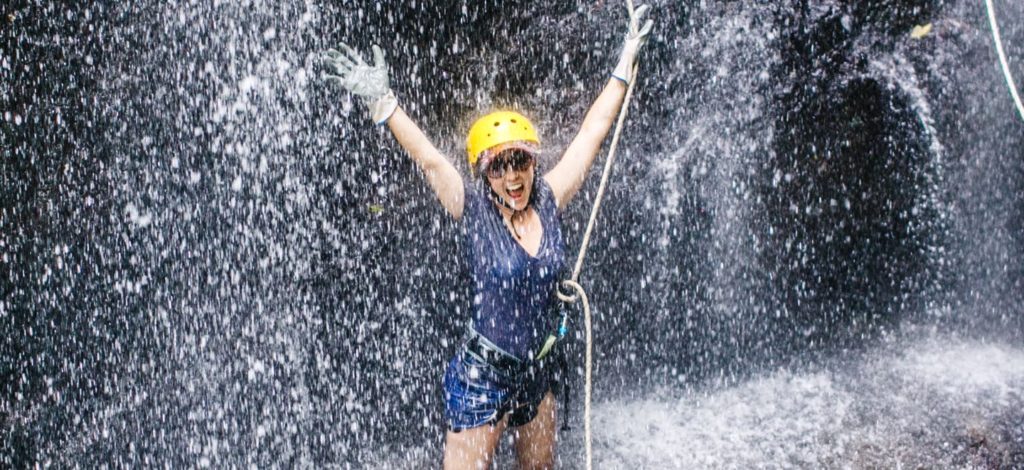
Instead of overstretching the body and forcing muscles into unnatural positions, we can use Applied Yoga Anatomy to strengthen and stabilize the body — and eliminate pain in the process.
Imagine a stereotypical bodybuilder for a sec. They’re jacked, with massive arms and shoulders. But often, their upper back is slumped, and their shoulders shrug up towards their ears.
A typical yoga teacher might tell them they need to stretch more, to focus on opening up through the shoulders. I disagree. I’m more interested in which muscles are weak — the ones we need to activate in order to support the spine for increased alignment, strength, and stability.
If you’re experiencing upper back pain, it could be that your glutes, pecs, or obliques aren’t firing correctly. Everything is connected.
Take a look at this video where I share a simple hack to relieve back pain.
I explain which activated muscles are crucial to a happy, healthy spine — and share a simple yoga exercise that will help get rid of upper back pain for good.
10 Yoga poses for upper back pain relief
Yoga is a fantastic tool to get rid of upper back pain. Just remember, the goal is to strengthen, stabilize and align the body — not stretch and pull our muscles where they don’t naturally want to go.
I recommend starting with my yoga flow for shoulder stability and safe backbends.
It’s a one-hour flow, safe for all levels, that will guide you through the proper muscle activations you need for back pain relief.
Now, for a few poses you can incorporate into your daily routine or practice, here are my top 10 yoga poses for upper back pain relief:
1. Bhujangasana (Cobra Pose)
We all spend a lot of time slumped over screens. As a result, our upper back muscles can turn off, creating pain or tension in the thoracic spine. Cobra Pose is an excellent way to strengthen the shoulders and back muscles and help with posture.
Lie down on your stomach with your palms flat next to your shoulders. You can walk them out slightly off your mat if that feels good. Inhale and begin to lift the head and shoulders off the ground.
We’re not trying to move as far into the posture as possible. Again, this is about activating the upper back muscles, not overarching the spine. Work with the breath, squeezing the shoulder blades together to lift higher off the ground on each inhale.
Pro tip: Don’t engage your glutes here. Focus on isolating the activation in the upper back and shoulder muscles instead.
2. Salabhasana (Locust Pose)
If you’ve ever been to one of my yoga classes, you know just how much I love Locust Pose — it almost always makes a guest appearance. That’s because it’s one powerful pose! Not only does Locust strengthen the upper and lower back, but it also aids in digestive issues and improves posture too.
Here’s a trick for preparing for Locust:
Start by lying on your stomach. Now, keeping the glutes relaxed, extend your arms in front of you. Pause. On the exhale, squeeze the shoulder blades together and bring the elbows back, so your arms form a W. Inhale and extend the arms. Repeat.
Continue the above exercise a few times until you feel the shoulder muscles fired up. Now, place the palms flat next to your shoulders. LIft one knee. Engage the glute as you fire the foot up towards the ceiling. Repeat, then switch sides.
Now you’re ready for Locust Pose. Extend the arms out in front of you. On the inhale, lift the head, torso, arms, and legs off the mat. Keep the neck lengthened. Hold for a few breaths, then release.
3. Phalakasana (Plank Pose)
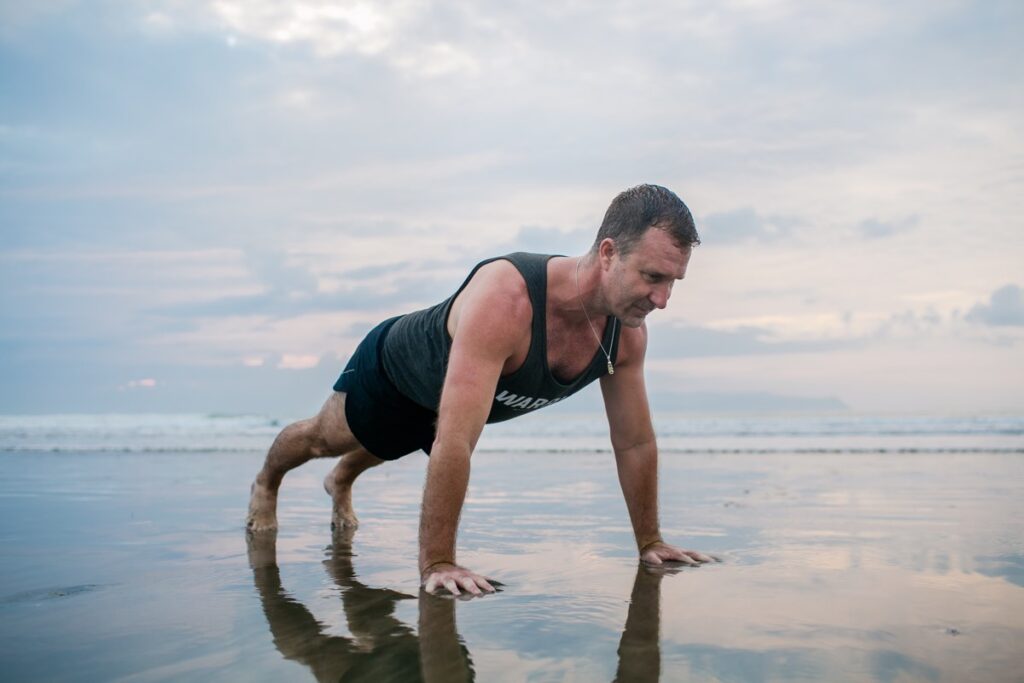
Most people don’t realize that the obliques and pecs play a considerable role in supporting the spine. If you watched the video for back pain I shared above, you now have an easy exercise to strengthen the obliques and combat upper back pain.
Plank Pose is another of my go-to yoga poses for upper back pain tension. It strengthens and stabilizes the entire core while promoting proper spinal alignment.
Engage your core and squeeze your glutes as you powerfully corkscrew your hands into the mat to come into Plank. Don’t let those shoulders shrug up towards the ears. Hold for 30 seconds or longer.
4. Setu Bandha Sarvāṅgāsana (Bridge Pose)
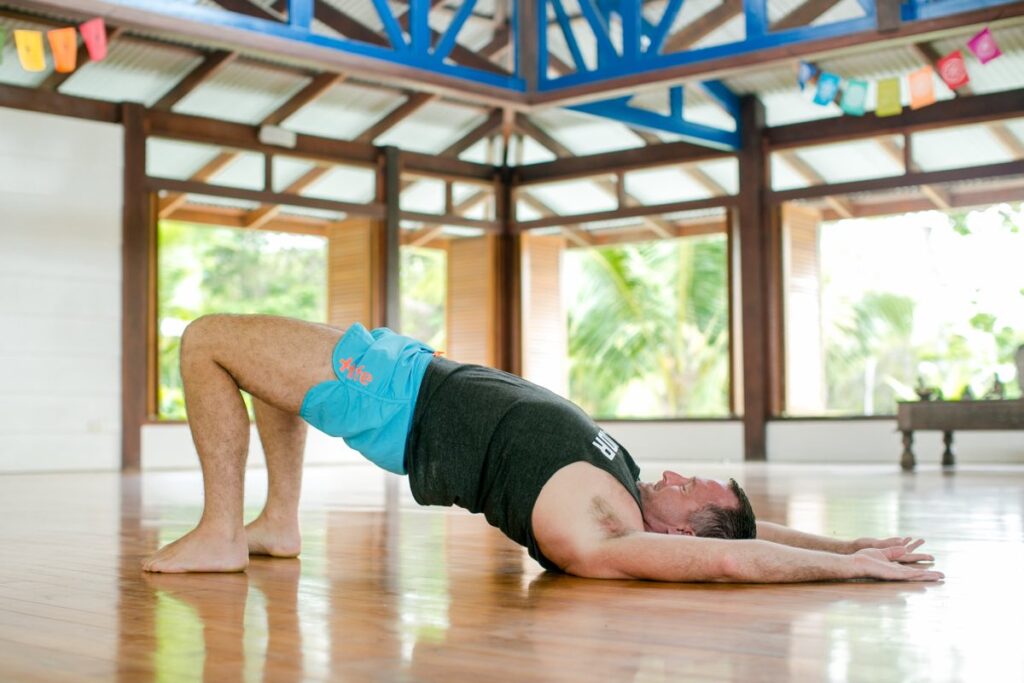
Do you know which muscles never tend to get enough love?
The glorious glutes.
The gluteus maximus muscle is one of the most important muscles in the human body. It’s a key shock absorber for the spine and keeps the hips and thighs functioning correctly. If you’re experiencing lower back pain or limited mobility, weak glutes could be to blame.
So, let’s fire up those glutes and strengthen the back with Bridge Pose.
Start by placing a block between your thighs. Drive your feet and shoulders into the ground and lift the hips, squeezing the block as you do so.
Repeat this process a few times, always moving with the breath.
5. Natarajasana (Dancer Pose)
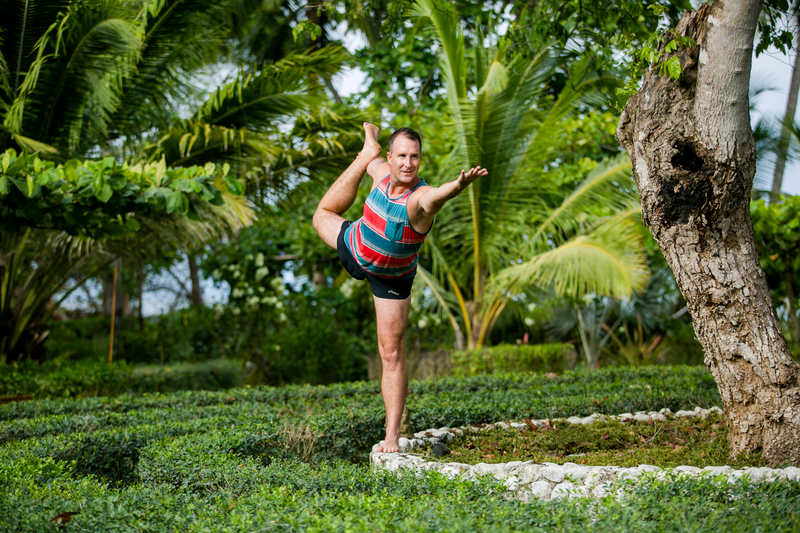
A representation of Lord Shiva, Dancer Pose represents the power of transformation. It brings out the energy within us to change ourselves and the world — because of that, it’s one of my favorite yoga poses!
I always encourage my students to practice Dancer Pose from a creative, playful space. That said, from an Applied Yoga Anatomy perspective, we need to know which muscles to stabilize and engage.
Here’s the thing:
Your glutes have to fire correctly to safely move into Dancer Pose and get relief from upper back pain.
Have a look at this video for a step-by-step walk-through of Dancer Pose.
6. Matsyasana (Fish Pose)
Boost energy and strengthen the upper back in this profoundly restorative pose. I love practicing a supported variation of Fish Pose; it’s especially great for those suffering from upper back pain.
Grab two blocks and position them beneath your thoracic spine and neck. Lie back onto the blocks, adjusting them as necessary. I like to use a higher level for the block beneath my back and a lower level for my neck, but do what feels right for you.
Draw your shoulder blades together and engage the core to support the spine and activate the upper back muscles.
7. Marjaryasana / Bitilasana (Cat / Cow Pose)
Cat / Cow is a popular start to many yoga classes, and for a good reason. It’s an excellent way to awaken the muscles up and down the spine, and the core, too.
Again, we’re not looking for hyper-flexibility. Don’t “push” the spine where it doesn’t want to go.
Begin in a tabletop position. On the inhale, drop the stomach towards the ground as you actively engage the shoulder blades towards one another. Exhale and push the ground away from you, contracting the core as you round through the spine. Continue working with the breath as you repeat the exercises 6-8 times.
8. Master Uttana Shishosana (Extended Puppy Pose)
Continuing our list of the best yoga poses for upper back pain relief is Puppy Pose. This backbend strengthens the hips and back muscles while also activating the ever-important abdominal muscles.
Start in a tabletop position. Begin to walk the hands forward. Don’t drop the elbows, but keep the arms engaged. Rest the forehead on the ground as you slightly push the hips back towards the heels.
I recommend squeezing a block between your legs to activate the glutes. You can also rest the head on a blanket to avoid over-extending through the spine.
9. Adho Mukha Svanasana (Downward Dog)
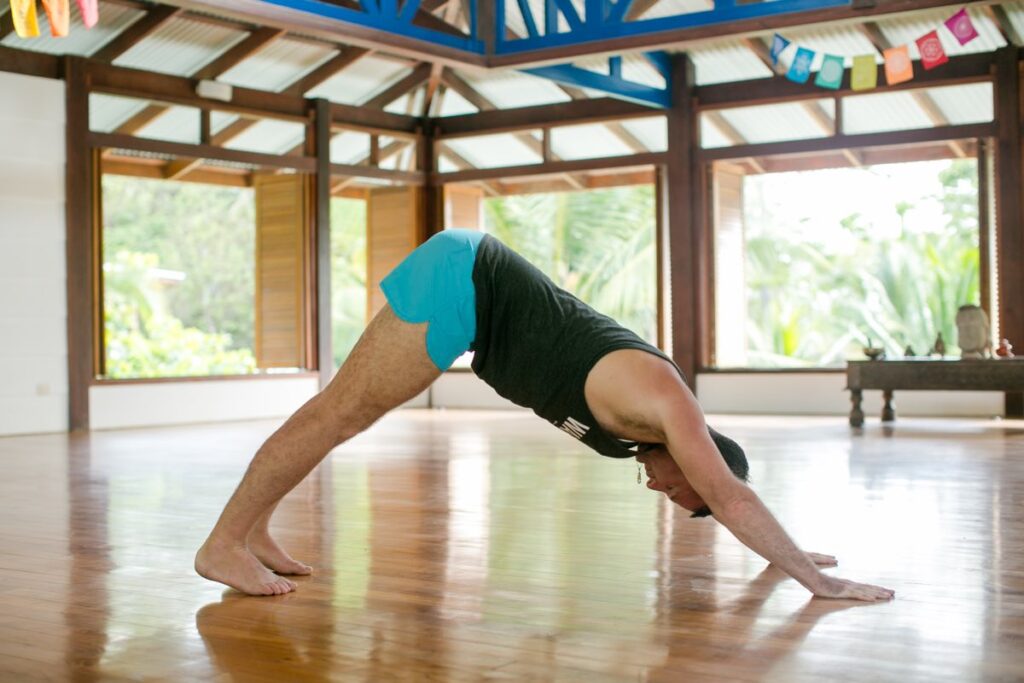
If upper back pain starts to creep in, hopping into your Down Dog can offer quick relief.
Downward Dog is powerful because it strengthens and aligns the entire body — the arms, shoulders, legs, and upper and lower back muscles.
From a tabletop position, shoot the hips up and back. Bend the knees as deeply as you need to; we want to create length and alignment in the spine.
Many people experience upper back pain because their shoulders are weak. Practice Downward Dog daily, and you’ll strengthen the muscles you need for better posture and spinal health.
10. Dandayamana Bharmanasana (Bird/Dog or Quadra Ped or Spinal Balancing Pose)
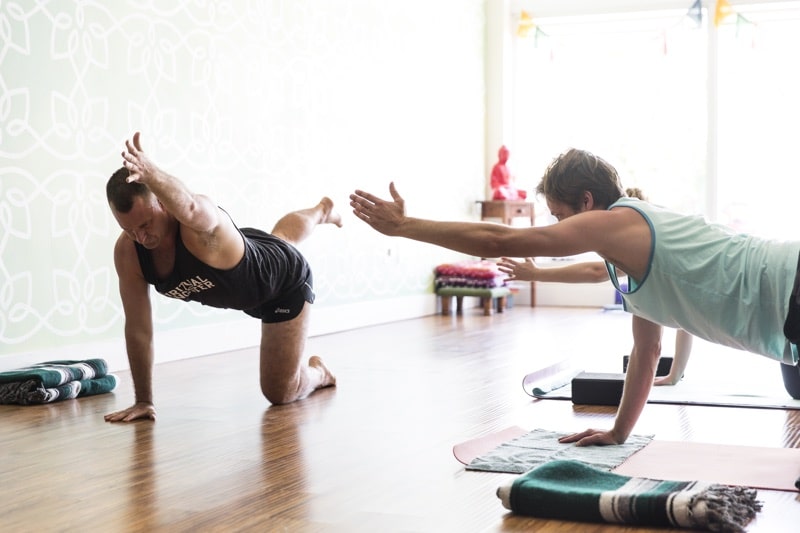
This pose has a few names, and depending on the kind of class or teacher you have, is taught a little differently.
For the purpose of healing upper back pain, the muscle we are particularly targeting is called the Multifidus.
One major muscle group that NEVER gets any press is the Multifidus.
The multifidus muscle consists of a number of fleshy and tendinous fasciculi, which fill up the groove on either side of the spinous processes of the vertebrae, from the sacrum to the axis. While very thin, the multifidus muscle plays an important role in stabilizing the joints within the spine.
Located just superficially to the spine itself, the multifidus muscle spans three joint segments and works to stabilize these joints at each level.
When you exercise the multifidus, you will bring more stability to your back, and especially your neck. If I start to have a lot of neck pain, I go back to doing this exercise and after three days, my neck pain is gone.
- Come on to all fours.
- Begin by lifting one of your back legs up.
- Keep the leg as straight as possible.
- Lift the opposite arm up as high as you can while keeping it straight.
- Keeping the arm straight, the leg straight, lift both up as high as you can again.
- Now twist your entire upper torso in the direction of the raised arm.
- Lower arm and leg, and repeat on the other side.
- Do this exercise 10 times on each side. If you have really bad back issues, do more.
How to heal your back pain for good
Incorporate the above yoga poses for upper back pain relief into your regular practice, and observe any differences in your long-term spinal health.
Now, this is only an introduction to yoga for back pain relief.
If you’re ready to revitalize your spine health for good — or help your yoga students safely eliminate back pain — then check out my online course for back health.
I reveal my personal experience with overcoming back pain, then go in-depth on the theory and exercises you need to achieve a healthy back and spine.
You’ll learn:
- An introduction to back health
- Strengthening versus stretching the back
- Essential back and muscle anatomy
- Muscle exercises for back health
- A safe + effective back health yoga sequence
There’s a free 15-day trial, so you can give it a whirl and start healing your back pain for good.
See you on the other side!
About Yogi Aaron

Yogi Aaron is the owner, operator, and lead yoga facilitator at Blue Osa and of the yoga teacher trainings.
Creator of Applied Yoga Anatomy + Muscle Activation™ Yogi Aaron brings three decades’ worth of study, mentorship, and experience into his teachings, with a strong emphasis on yoga therapy and alignment.
The Muscle Activation Yoga Classes is an exploration into your body, its muscles, and to learn how to improve its function through using Applied Yoga Anatomy + Muscle Activation™.
Find out more about yoga teacher trainings with Yogi Aaron at Blue Osa Yoga Retreat + Spa.
Read More about Applied Yoga Anatomy + Muscle Activation
Book/Inquire Now
Got pain? This will help you!
YOU DESERVE TO LIVE PAIN-FREE...
Receive 7 short, simple, and effective practices to alleviate knee, hip, low back, neck, shoulder pain, and more!
All you need is 5 minutes per lesson and it's FREE!
This revolutionary approach to yoga is new, and no one else is teaching this! Since I created Applied Yoga Anatomy + Muscle Activation™ and started teaching it consistently, I've witnessed students heal long-standing injuries, access yoga postures they never thought possible, and tell me over and over again how their body just feels better.
I hope you'll join me on this journey!
~Yogi Aaron
Is Yoga Teacher Training Right For Me?
We Created This FREE 5 Part Series So You Can Get All The Information To Make The Right Choice.
In this series, you will learn:
-
- Am I a candidate for yoga teacher training??
-
- What will I learn in a YTT?
-
- Do I need to have a perfect downward dog to attend YTT?
14-Day 200-Hour Yoga Teacher Training in Costa Rica
If you are looking for a 14-day 200 hour Yoga Teacher Training Costa Rica Immersion, you have landed in the right place. Join the next one!
300-Hour, 28-Day Yoga Teacher Training
Do You Feel Called To Something Greater?
This 300-Hour Yoga Teacher Training immersion training at Blue Osa will immerse you in yoga for one month.
You will have the specific transformational skills and yogic practices you need in order to connect with your higher purpose.
And more! You will be able to offer these transformative skills to others!

